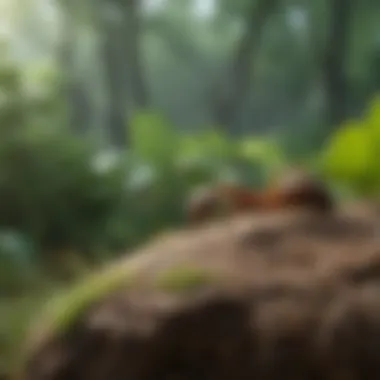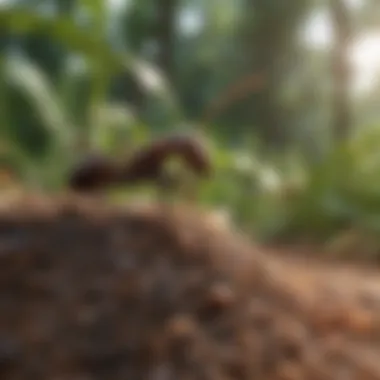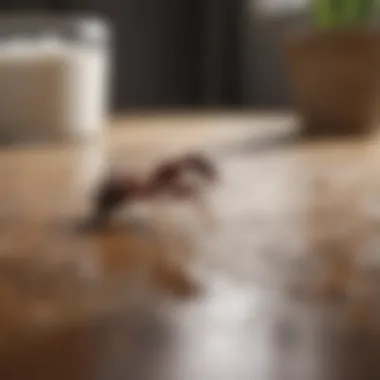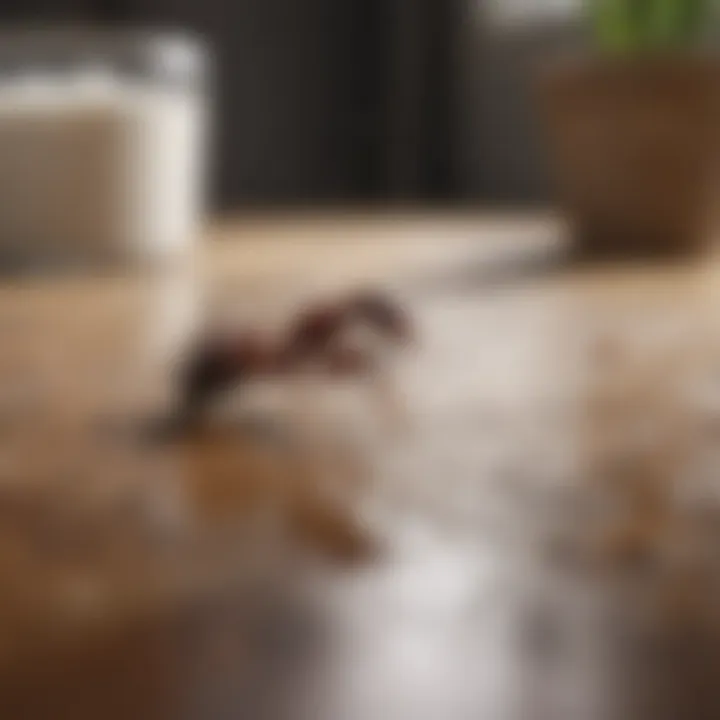Effective Strategies for Keeping Sugar Ants Away


Intro
Sugar ants have a way of creeping into our lives uninvited, like that distant relative who overstays their welcome. Just when you think your kitchen is safe, these tiny, industrious pests make their grand entrance, searching for sweet morsels. Understanding sugar ants’ behavior can be as crucial as knowing the layout of your own home. By identifying what attracts these pesky critters and implementing a few effective strategies, you can safeguard your abode and learn how to keep them at bay.
This guide serves as a handbook, offering not only practical advice but also delving into the psychology behind these pests. You’ll uncover insights about their habits, the substances that lure them, and both natural and chemical deterrent strategies. Your journey to an ant-free environment starts here.
Key Insights and Trends
Effective strategies for deterring sugar ants are heavily influenced by contemporary understanding of ant behavior and trends in environmental solutions. Let’s break it down a bit.
Understanding Sugar Ant Behavior
Sugar ants are incredibly social insects, forming large colonies that can quickly invade a space once they find a food source. It’s important to note their preference for sweet and sugary substances—think of it as their version of a gourmet dessert buffet. Identifying these food attractants in your home, such as leftover soda, sweet fruits, or crumbs on the counter, is the first step to hindering their advance.
Current Trends in Pest Control:
- Eco-Friendly Products: Many homeowners are moving towards non-toxic options for pest control. Solutions like diatomaceous earth and essential oils not only deter sugar ants but are also safer for children and pets.
- DIY Solutions: People are increasingly exploring do-it-yourself concoctions using household items. Vinegar, for example, is known to disrupt their scent trails.
Sugar Ant Prevention Methods
Regular upkeep reinforces the home against sugar ant intrusions. A few areas to pay close attention to are:
- Seal Entry Points: Inspect your home for cracks or gaps around windows and doors. These act like open invitations.
- Regular Cleaning: Maintaining a clean environment ensures that sugar ants are not drawn to food scraps or spills.
- Food Storage: Store food in airtight containers to keep sweet substances away from their reach.
Practical Tips and How-To Guides
When it comes to keeping sugar ants from making a meal out of your home, having a detailed action plan can make a world of difference.
Step-by-Step Guide to Sugar Ant Deterrence:
- Identify and Eliminate Food Sources:
- Seal Gaps and Cracks:
- Use Natural Repellents:
- Set Up Ant Baits:
- Regularly Clean and Maintain:
- Carefully inspect for food items that might attract ants. Remember that even the smallest of crumbs can seem like a feast to them.
- Use caulk or other sealing materials to close off any potential entry points that sugar ants could find.
- Create a mixture using vinegar and water in a spray bottle. This can be sprayed around ant trails or entry points.
- If necessary, consider using commercial ant bait traps that contain ingredients such as boric acid, effective in managing sugar ant populations.
- Wipe surfaces with soapy water or vinegar frequently to avoid leaving any bait behind.
Maintaining Cleanliness:
Consistent cleaning habits might seem tedious, but they are like an insurance policy against pest intrusion. Establishing a regular routine for deep cleaning kitchen surfaces, floors, and pantry spaces will help you stay ahead of potential ant infestations. Keeping a close eye on things like open bags of sugar or fruit left out can make all the difference.
"The best offense is a good defense."
Taking steps to deter sugar ants proactively is far better than dealing with their invasions after the fact.
The End
In summation, understanding sugar ants is not merely about combating an annoying pest but about crafting a lifestyle that doesn’t give them a foothold in your space. By implementing effective strategies and maintaining cleanliness, you set the stage for a more comfortable and welcoming home without unwanted guests.
Understanding Sugar Ants
Understanding sugar ants plays a crucial role in effectively keeping these pests at bay. Knowledge about their biology and behavior is key to implementing strategies that prevent infestations. By familiarizing oneself with the environmental conditions that favor sugar ants, as well as the structure of their colonies and daily occurrences, homeowners and enthusiasts can craft a more effective approach to pest management. Gaining insight into these aspects arms individuals with the tools to identify potential problems before they escalate.
Species Overview
Sugar ants, or Camponotus consobrinus, are often mistaken for various other ant species due to their prevalence in homes. Viewing their shiny black and orange-brown bodies, it's easy to see why people may not pinpoint them right away. These ants are primarily found in Australia, and they have been known to travel in search of food over considerable distances. Their problem arises when they infiltrate homes, seeking sweet substances and soft, decaying materials.
Behavioral Patterns
The behavior of sugar ants tends to be rather interesting. They are most active during warmer months, which aligns with their foraging patterns. Typically, these ants are attracted to sugary substances, leaving behind pheromone trails. When one ant finds food, it releases a scent that beckons others to join in. This is when a small troop can seem to appear out of nowhere, marching in a line right to your kitchen counter.
"Their foraging strategy revolves around the quick gathering of resources and efficient navigation - an element worth noting when attempting to prevent them from overtaking your space."
During the night, sugar ants are known to be more active, scurrying about where there's less human activity. Their ability to adapt to various environments allows them to find shelter in less accessible locations, making it harder to pinpoint and eliminate their nests.
Colony Structure
Sugar ant colonies can be complex and resilient. Each colony can contain thousands of ants, segmented into different roles; workers, soldiers, and nursery ants take different responsibilities. Successful deterrence strategies must factor in the colony's organization. If you disturb one section, others readily compensate. The queen is central to the colony's growth and survival. When destroying or treating, it’s essential to target not just the workers but to consider the long-term effects on the entire colony.
What Attracts Sugar Ants


Understanding what draws sugar ants to your home is crucial for effective prevention and control. Sugar ants are opportunistic feeders, and their presence often indicates that your space offers something delectable, enticing these pests to set up shop. By identifying the specific elements that attract them, you can take proactive measures to mitigate the risk of infestation. Focusing on food sources, environmental conditions, and seasonal influences provides a well-rounded approach to deterring these pests before they become a persistent issue.
Food Sources
Sugar ants thrive on sugary substances, which is where they get their name from. They have an affinity for sweet things but are not picky eaters. They will happily munch on any food items left unattended. It's not just sugar that tempts them; they are drawn to a variety of food sources, including:
- Sugary foods: Candy, syrup, pastries, and fruits lay out a welcome mat.
- Greasy foods: Leftover oil or butter can lure them in as well.
- Pet food: Unattended pet bowls can be a buffet for these little intruders.
- Waste: Open trash cans or compost bins also invite visits.
If you’re seeing these pesky ants marching in a single file across your kitchen counter, it’s likely because they’ve found something they fancy. Keeping food sealed tight and minimizing crumbs can significantly reduce their attraction.
Environmental Conditions
Sugar ants, like many insects, have a penchant for specific environmental conditions that help them flourish. Warm and humid environments are particularly appealing to them. Factors such as:
- Moisture: Areas with leaks or high humidity offer a haven for sugar ants.
- Warm temperatures: They prefer temperatures between 70°F to 85°F, which is typically found indoors during the warmer seasons.
- Shelter: Cracks in walls and foundations, as well as vegetation close to the home, can serve as perfect nesting sites.
If these conditions exist in your home, you might as well roll out the welcome mat for sugar ants. Take a hard look at your living environment and address any issues that might be drawing them in—fixing leaks and sealing up gaps goes a long way.
Seasonal Influences
The time of year can play a significant role in sugar ant activity. Seasonal changes can drive these ants to seek food or shelter, so understanding these patterns can prove beneficial. For example:
- Spring: As temperatures begin to rise, sugar ants become more active. They forage for food to replenish their colonies after winter.
- Summer: The hot weather can push them indoors where it's cooler and food is plentiful.
- Fall: As the weather cools down, sugar ants often invade homes looking for a warm place and food to prepare for winter.
- Winter: While their numbers dwindle, any nests close to warmth or open food sources may still pose a threat.
By understanding these seasonal shifts, homeowners can better prepare for potential infestations, adapting cleaning routines and food storage accordingly.
It is vital to recognize that prevention starts by eliminating the elements that attract sugar ants in the first place. Identifying food sources, enhancing the living environment, and understanding seasonal changes are key to safeguarding your home from these unwelcome visitors.
Cleaning to Deter Sugar Ants
Keeping your home clean does more than just freshen the air; it plays a crucial role in deterring sugar ants. Understandably, these little critters are not just nuisances; they can quickly turn an otherwise charming dwelling into a battlefield. Sugar ants have a knack for locating food, and if yours has fragrance, it might as well be a flashing neon sign for their foraging troops. This section delves into various cleaning practices that can significantly reduce the chances of an ant invasion, providing effective and actionable strategies for maintaining a sugar ant-free environment.
Regular Cleaning Routines
A consistent cleaning schedule can go a long way in keeping sugar ants at bay. Daily routines should focus on key areas where food particles are likely to accumulate. Here are some helpful tips to incorporate into your cleaning regimen:
- Sweep and Vacuum: Make it a habit to sweep your floors daily, especially in the kitchen and dining areas. Sugar ants, as the name suggests, are attracted to sweet substances. Crumbs from yesterday’s snack can invite a parade of ants. Vacuuming carpets and rugs can also help in catching hidden particles.
- Wipe Surfaces: After each meal, utilize a damp cloth to wipe down countertops, tables, and other surfaces. Using a mild detergent mixed with water can help eliminate any pheromone trails left by the ants, which guide fellow ants to the food source. This little detail can make a big difference in fending off future visits.
- Deep Cleaning Weekly: Dedicate time each week to clean under appliances, behind furniture, and in hard-to-reach corners. Dust bunnies can provide a perfect hiding spot for these critters. Prioritizing areas that are frequently overlooked can dilute the chances of sugar ants making a cozy home in your living space.
Proper Food Storage
Storing food correctly can be a game-changer. If your pantry resembles a candy store, sugar ants will find their way in faster than you can say "ant invasion." Taking the time to invest in solid storage methods helps immensely. Consider the following:
- Airtight Containers: Use containers that seal tightly to keep food fresh and pests away. Clear plastic or glass containers not only keep sugar ants out but also allow you to see what’s inside at a glance. This might be especially useful when you're in a rush, preventing accidental spills that can attract these critters.
- Label Everything: Labeling makes it easier to keep track of food items while maintaining organization. It ensures you can locate things quickly and helps avoid leaving jars open or bags unsealed.
- Refrigerate: Perishables like fruits and sweets should be refrigerated. Even items that may not seem exotic, like leftover cakes or cookies, can become a sweet treat for sugar ants enthusiastic for a snack. Keeping these items chill can keep them from becoming a free buffet.
Sealing Entry Points
Ants don’t just find their way into your house through the glaringly obvious. They can slip through the tiniest cracks and crevices, so being meticulous about sealing potential entry points is paramount. Some strategies to consider:
- Inspect and Repair: Regularly check the seals around windows and doors. If you notice gaps, consider using caulk or weather stripping to seal them. It’s an overlooked detail that can yield mighty results.
- Check Pipes and Vents: Look for gaps around plumbing and vents where ants could slip in. A simple way to block access is to use expanding foam or mesh screen.
- Keep Outside Clean: Keep your yard tidy by trimming any nearby bushes or trees that may give ants a shortcut to your home. Ants are notorious climbers, and branches can act as bridges leading to your indoor paradise.
"An ounce of prevention is worth a pound of cure." This seems to ring true when dealing with sugar ants. The more proactive you are about cleaning, storing food, and sealing entry points, the less likely you are to face an infestation.
Natural Deterrents
Natural deterrents play a crucial role in managing sugar ants, offering homeowners a less toxic and more eco-friendly approach. Utilizing these deterrents not only reduces reliance on chemicals, which can be hazardous to family and pets, but they also foster a preventive mindset, encouraging regular maintenance and vigilance against potential infestations. Each natural method mentioned here is relatively easy to implement, providing an added layer of protection while enhancing the ambiance of your space with delightful scents and flavors.
Essential Oils
Essential oils are potent allies in the battle against sugar ants. Oils like peppermint, tea tree, and lemon not only smell great but can significantly disrupt the scent trails that ants use to navigate. When sugar ants come across these oils, their pathways are rendered ineffective, leading them astray. To create your deterrent, mix a few drops of essential oil with water in a spray bottle and apply it to areas where you’ve seen ant activity. It’s like a fresh coat of paint for your home that keeps uninvited guests at bay.
"Ants rely heavily on their sense of smell; disrupt that, and you can keep them guessing."
One important consideration is to test the surfaces you're spraying to ensure no adverse reactions occur. Regular reapplication is essential to maintain efficacy, especially after cleaning or if the area becomes noticeably damp. Plus, the harmonious aroma filling your space can be an added bonus.
Vinegar Solutions
Vinegar solutions are another tried-and-true method for deterring sugar ants. The high acidity of vinegar disrupts their scent trails and can effectively mask any lingering smells that may attract them. To make this solution, combine equal parts of white vinegar and water in a spray bottle. After a simple shake, it's ready to go!
Not only does this method help in repelling ants, but it also doubles as a fantastic cleaner for your surfaces. Regular use can break the cycle that brings these tiny invaders into your home. Just remember that vinegar’s strong scent dissipates quickly, so consistent application is necessary to maintain control over ant activity.
Herbs and Spices
Harnessing the power of common herbs and spices can yield surprising results in your fight against sugar ants. Certain herbs, such as basil, mint, and rosemary, are particularly unappealing to these pests. Strategically placing pots of these herbs near entry points or around the perimeter of your property can provide a natural barrier.


Additionally, the use of spices like cinnamon, cayenne pepper, or black pepper can help in disrupting ant trails. Sprinkling these on pathways they frequent may deter them from establishing a presence in your home.
A key benefit of employing herbs and spices is that they not only serve as a defense mechanism but also contribute to the aesthetic appeal of your home or garden, enhancing your indoor and outdoor spaces. To maximize effectiveness, regularly assess and refresh any natural deterrents you use, as their efficacy can diminish over time.
In sum, employing natural deterrents provides a sustainable approach to managing sugar ants. With essential oils, vinegar solutions, and herbs or spices, you can build a comprehensive shield of defense against these invasive little critters while enjoying the benefits of a scented and inviting living space.
Chemical Control Options
When it comes to tackling sugar ants, sometimes the most effective course of action involves chemical control. These methods can be particularly beneficial when natural deterrents just don’t cut it. The importance of chemical options lies in their ability to quickly reduce ant populations, especially during an outbreak. However, understanding how to use them responsibly is crucial; these strategies come with potential risks and must be part of a broader pest management plan.
Insecticides
Insecticides are commercial formulations designed specifically to kill ants. They’re available in various forms, such as sprays, granules, and concentrated liquids. Here are several considerations when using insecticides:
- Types: There are synthetic and natural insecticides. Synthetic versions often have faster action but may raise concerns about safety, especially around pets and children. Products containing permethrin or bifenthrin are commonly used against sugar ants. Natural insecticides, on the other hand, include compounds like diatomaceous earth which is less hazardous.
- Application: Applying insecticides requires meticulousness. Ensure you target areas where sugar ants tend to gather. This includes kitchen countertops, entry points, and trails. Read and follow the instructions thoroughly for the best results. Under-application might not solve the infestations, while over-application could pose health risks.
- Effectiveness: While insecticides can significantly reduce visible ant populations, they don't usually address the root of the problem—namely, the colony itself. Thus, combining these with other strategies, such as baits, is vital for a truly effective pest control approach.
"Chemical control options have their place in a comprehensive pest management plan but should be used judiciously to minimize risks."
Baits and Traps
Baits and traps are often seen as a vital element in controlling sugar ants. These products lure ants with a food source that is mixed with a slow-acting poison. The worker ants carry this bait back to the nest, effectively distributing the insecticide to the entire colony.
- How they work: Baits are typically formulated with a sugar component, making them attractive to sugar ants. Look for products that contain ingredients like fipronil or boric acid, which are commonly found in commercial ant baits.
- Placement: Proper placement of baits can make or break their effectiveness. They should be placed near ant trails or entry points, away from pets and children. Observe where the ants are most active to determine optimal locations.
- Patience: One key aspect to remember is that baits can take time to show results. Expect to wait a few days as ants eat the poison and share it with the colony. If baits are not effective after a week, it might be best to attempt other forms of intervention.
Sprays and Powders
Sprays and powders provide immediate relief by killing on contact and deterring future activity. They can be used both indoors and outdoors to protect your space from sugar ants.
- Types of products: Residual sprays leave a lasting effect after application. Powders, such as boric acid, can be applied in crevices and other hard-to-reach places where ants travel.
- Application tips: When using sprays, aim them at the areas with significant ant activity. Avoid spraying directly on surfaces that can come into contact with food or children's toys. For powders, a light dusting is often enough; an over-application can be wasteful and ineffective.
- Safety Considerations: Choosing safer formulations can mitigate health risks. Always check for instructions regarding safety practices, and ensure proper ventilation during application.
By understanding these chemical control options, homeowners can better equip themselves to manage sugar ant infestations effectively. Incorporating these methods into your pest control strategy, while remaining aware of their application risks, can provide an effective path toward regaining control over your living space.
Preventing Future Infestations
Keeping sugar ants away for good requires more than just a temporary fix. It's about establishing a solid foundation of preventive measures that not only addresses current issues but also discourages future outbreaks. This is particularly crucial as ants are not just pests but also an indication of more extensive cleanliness and structural issues within your home. Understanding how to effectively deter these little invaders can save time, money, and a lot of frustration in the long run.
Long-term Maintenance Strategies
Sustaining a sugar-ant-free environment requires diligence and ongoing effort. Here are some long-term maintenance strategies to consider:
- Routine Inspections: Regularly check your home for potential nesting sites. Pay close attention to corners, under appliances, and in cabinets where food might be stored.
- Regular Cleaning: It can't be overstated: a clean home is a less inviting one. Wipe down counters, sweep floors, and ensure food spills are addressed promptly.
- Strategic Landscaping: Trim back any vegetation that touches your home’s exterior. Brush or trees acting as bridges can make it easier for sugar ants to invade.
- Monitor Moisture Levels: Since ants congregate near water, fix any leaky pipes or faucets. Proper drainage in your yard can also help in steering these pests away from your property.
Investing time in these strategies reinforces the infrastructure you’ve created to keep the ants at bay. It's a continuous cycle of vigilance and action.
Community Awareness
Sugar ants are not just a household nuisance; they are a community issue. Open communication with neighbors can be valuable. Here’s why:
- Shared Knowledge: Discussing pest control methods with neighbors can yield innovative solutions. Share what works and what doesn’t; after all, success stories and failures alike can provide insight.
- Collective Responsibility: Sugar ants can migrate from house to house. If your neighbor has an issue, it might just be a matter of time before they land on your doorstep. Forming a community action plan can promote a cleaner, less favorable environment for the ants.
- Local Resources: Sometimes, community organizations provide pest control resources. Look out for local workshops or remediation services that could further aid in maintaining a pest-free environment.
Overall, fostering community awareness cultivates a collective mindset towards tackling the problem effectively. It spreads best practices across households, leading to a more significant impact than siloed efforts.
"The trouble with ants isn’t just getting rid of them. It’s about ensuring they don't come back."
In summary, addressing sugar ant infestations is not merely about reactive measures. It's the proactive steps, both at an individual and community level, that can effectively prevent future infestations. Whether through meticulous long-term strategies at home or by promoting collective efforts within neighborhoods, these preventive measures create a formidable barrier against these industrious pests.
Identifying and Understanding Nest Locations
Understanding where sugar ants make their homes is crucial for effective pest management. If you want to kick these little critters to the curb, knowing their nesting locations can give you a solid upper hand. It's not just about sending them packing; it’s about ensuring they don’t come back with their friends.
For homeowners, focusing on where sugar ants establish their nests can yield benefits. Identifying these spots lessens the chances of repeated infestations. When you know where they like to hang out, you can take targeted actions that are far more effective. It also saves time and resources, allowing you to pinpoint your efforts instead of fumbling around in the dark.
Another important consideration is that ants can indicate an issue. If you keep finding trails or nest sites, it might suggest there are underlying problems like moisture or food sources that need attention. Addressing these factors can create a long-lasting solution, turning your home into a less inviting space for these pests.
"Spotting the nest often gives insight into the colony’s size and structure, allowing for tailored intervention approaches."
Indoor Nesting Sites
Sugar ants are sneaky and can find a cozy corner in your home to establish their colonies. They prefer spaces that provide moisture and food, often leading them to kitchens, bathrooms, and even under appliances. A common spot for these little invaders is behind cabinets or beneath sinks.
Here are a few red flags that might point to indoor nesting sites:
- Sugar Crumbs: A clear sign there are sugar ants in the vicinity can be found in the form of crumbs around kitchen counters or dining areas.
- Moist Areas: Look for dampness under sinks or in corners of the bathroom. Sugar ants are generally attracted to moisture and food.
- Wall Cracks and Gaps: Check for tiny holes in walls or cracks where wires or pipes penetrate. These can serve as entry points.


The structure of your home plays a key role too. Sugar ants can thrive in cracks and crevices, making it essential to keep your living areas tidy and sealed off. Noticing trails moving towards a specific location can also clue you in on potential nesting sites.
Outdoor Habitats
Outside, sugar ants thrive in warmer, sheltered environments. They often set up shop under stones, in decaying wood, or within garden beds, making outdoor management a bit trickier. These habitats allow the ants to remain concealed while they forage for food and moisture.
When you’re looking for nests outdoors, consider the following:
- Garden Beds: Check around the roots of plants or under mulch. Sugar ants are known to be drawn to organic material and can create sprawling colonies in these locations.
- Wood Piles: Decaying or even dry wood stacks can be magnets for sugar ants. These areas provide a perfect shelter and food source.
- Sidewalk Cracks: Pay attention to gaps in concrete or asphalt. Sugar ants have no qualms about nesting in these crevices.
In summary, both indoor and outdoor environments can provide suitable habitats for sugar ants. Identifying their nesting locations not only helps in executing a plan to keep them out but can also inform broader strategies for future prevention. This understanding lays a strong foundation for the subsequent steps to effectively deter sugar ants.
Timing of Intervention
Understanding the timing of interventions when it comes to sugar ants can significantly impact your success in managing these pests. Ants have particular life cycles and behavioral patterns that can change with the seasons. Knowing when they are most active can help in planning effective deterrence strategies.
Many folks underestimate the importance of a well-timed approach. This can lead to wasted efforts and even encourage the ants to thrive despite your best attempts. The concept revolves around being proactive rather than reactive, allowing you to take control before a small issue becomes a larger infestation.
Seasonal Awareness
Each season carries its own set of challenges regarding ant behavior. Here’s a brief overview:
- Spring: As the weather warms up, sugar ants emerge from their hibernation, eager to explore and forage. This is often when the population surges, with worker ants scouring for food. Key strategies during this time:
- Summer: This is peak season for sugar ants. Ant colonies can expand rapidly, and populations can range from dozens to thousands.
- Fall: Ants prepare for the winter. They'll look for warm nesting spots.
- Winter: Ant activity typically slows down, but that doesn't mean they disappear entirely. Some species may nest indoors during the colder months.
- Inspect your surroundings: Look for any signs of their presence.
- Seal off entry points: Weather stripping can come in handy at this point.
- Maintain cleanliness becomes crucial. Make sure that no food scraps are left behind, and check outdoor areas for any debris that may attract them.
- Focus on barriers: Perform a final sweep of your yard and home.
- Evaluate indoor ant control strategies, such as baiting systems.
Identifying these seasonal patterns helps in crafting a tailored approach to deter sugar ants. It’s not just about reacting when you see them; it’s about anticipating their moves and planning accordingly.
Peak Activity Periods
During specific times of the day or particular conditions, sugar ants tend to be more active. Recognizing these peak activity periods can allow for effective intervention:
- Time of Day: Sugar ants are generally most active during the early morning and late afternoon. This aligns with their foraging behavior to search for food. Observing their activity can help in pinpointing the most effective times for applying natural deterrents or chemical products.
- Weather Conditions: Rainy conditions often lead to increased indoor activity. If there’s a thunderstorm, ants may rush indoors to escape the wet, making timely interventions necessary during this weather.
By understanding both the seasonal changes and peak activity periods, homeowners can sharpen their focus on strategic interventions. Ultimately, timing your actions not only saves effort but also increases the likelihood of keeping your environment ant-free.
"Prevention is better than cure." Planning your defenses around these elements makes all the difference in creating an unwelcome space for sugar ants.
Expert Advice
Understanding how to effectively address an issue with sugar ants can be both a daunting and intricate task. Often, homeowners underestimate the complexity involved in controlling these tiny pests until they find themselves in a real pickle, battling an active infestation. Expert advice serves as a beacon in such scenarios, guiding you through practical strategies to deter sugar ants effectively.
Consulting Pest Control Professionals
The notion of tackling a sugar ant problem by yourself can be tempting; many individuals feel confident enough, following various online tips and tricks. However, sometimes it's worthwhile to tap into the expertise of pest control professionals. These experts bring not only knowledge but also a wealth of experience to the table. They have seen it all — from the stubborn colonies that refuse to budge to the peculiar behavior patterns these ants display. In fact,
"A stitch in time saves nine" — this saying rings quite true; addressing an ant problem before it escalates can save homeowners from a real headache down the road.
When you consult with a specialist, they can help identify the specific species of ants invading your space, providing insights that are crucial for developing effective management strategies. Additionally, experts often have access to products and solutions that aren't available to the general public. This means you could benefit from professional-grade deterrents, which are usually more effective than off-the-shelf items.
When to Seek Help
Recognizing the right time to bring in the pros isn’t always straightforward. Homeowners should be aware of certain signals indicating that external help is needed. If you notice an ever-increasing number of ants, particularly if they seem to be marching in an organized colony, it might be time to get an expert involved. Similarly, if you've attempted DIY methods but to no avail, do not hesitate to reach out for professional assistance.
A few telltale signs include:
- Visible trails of ants leading to food sources.
- Nesting activity inside your home, often indicated by sightings of the ants themselves or the appearance of ant trails.
- Recurrent infestations during different seasons, which could suggest an underlying issue that needs attention.
Culmination
The role of a well-thought-out conclusion in this article is paramount. It serves not only as a summary of strategies discussed but also highlights the core principles that underlie effective sugar ant management. By revisiting key points, readers can crystallize their understanding of how these strategies interact and build on one another.
Summarizing Effective Strategies
To effectively deter sugar ants, several strategies, both proactive and reactive, have been outlined:
- Regular cleaning and maintenance: This is the crux of prevention. Keeping surfaces devoid of food particles and spills should never be overlooked. A consistent cleaning routine can deter ants from making a beeline to your home.
- Proper food storage techniques: It's wise to store food in airtight containers, ensuring that the sweet scent of your snacks doesn’t beckon these industrious little creatures.
- Natural deterrents: Using essential oils or vinegar for cleaning can disrupt the ants' pheromone trails, making it harder for them to navigate to their food sources.
- Chemical solutions: In case of heavy infestations, insecticides, baits, or trapping could provide immediate relief, but should be considered with care to not disrupt the household ecosystem.
Each of these strategies has a role to play in making your abode less appealing to these unwelcome visitors.
Future Considerations
Homeowners should consider seasonal changes that might affect sugar ant behavior. As the weather warms up, ants become increasingly active, particularly in regions where they thrive. Being vigilant during these times is crucial. Incorporating long-term preventative measures into your household routine can significantly reduce the risk of future infestations. This includes not just cleanliness but also awareness—knowing when and where sugar ants are likely to show up is half the battle. Furthermore, fostering community awareness about pest control can aid in addressing infestations on a larger scale. Sharing tips, personal experiences, or even contacting local pest control authorities can bolster the efforts of individuals.



